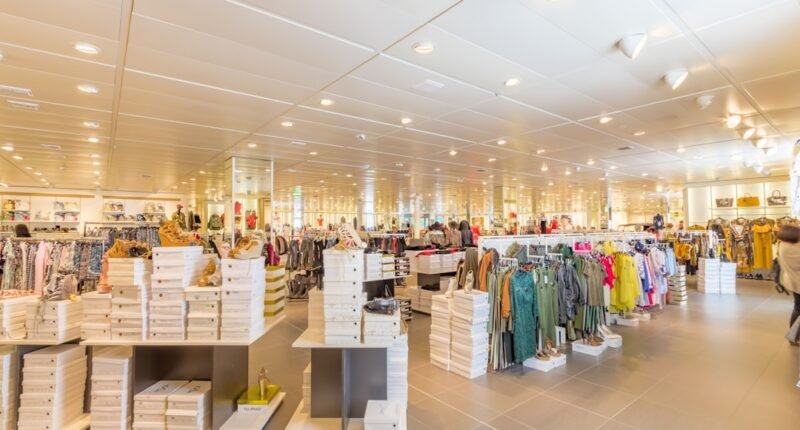Retailers must stay ahead of the curve in the fast-paced, fiercely competitive fashion industry of today. Fashion retailers must come up with creative ideas to boost their online visibility, increase productivity, and offer a flawless customer experience in light of the growing trend of e-commerce. This is the situation in which Shopify apps are useful. Fashion retailers can increase sales, optimize their online stores, & streamline operations with the help of Shopify apps.
Key Takeaways
- Shopify apps can greatly benefit fashion retailers
- Benefits of using Shopify apps include improved inventory management and order fulfillment
- Top Shopify apps for fashion retailers include Oberlo, Printful, and Refersion
- YouTube influencer database can be a valuable tool for promoting fashion retail stores
- The future of fashion retail is closely tied to the use of Shopify apps and social media influencers
This post will explain how utilizing Shopify apps can help fashion retailers increase sales, order fulfillment, and inventory management. It will also give a thorough rundown of the best apps that are currently available. The significance of social media, specifically YouTube, in the fashion industry will also be discussed, and the YouTube Influencer Database will be presented as a useful resource for fashion retailers.
Fashion retailers can benefit greatly from using Shopify apps in many ways. First off, by automating a variety of chores & procedures, these apps can significantly increase efficiency. Retailers can save time and effort by employing apps such as Oberlo, which facilitate the easy import and syncing of products from suppliers. To further simplify order fulfillment, apps such as Order Printer can automatically print packing slips, shipping labels, & invoices. The second way that Shopify apps can improve customer satisfaction and loyalty is by improving the overall customer experience. Customers can provide reviews and ratings through apps like Product Reviews, which help the retailer gain credibility & trust.
Customers can receive relevant and targeted messages by using apps like Klaviyo, which enable personalized email marketing campaigns. Customers may feel appreciated and be more likely to make repeat purchases as a result of these tailored interactions. And last, Shopify apps have a direct impact on higher sales. Retailers can grow their subscriber list and collect email addresses with the aid of apps like Privy.
| App Name | Description | Price | Rating |
|---|---|---|---|
| Product Reviews | Allows customers to leave reviews on products | Free | 4.7/5 |
| SEO Image Optimizer | Optimizes images for search engines | 20/month | 4.9/5 |
| Abandoned Cart Recovery | Sends automated emails to customers who abandon their cart | 8.99/month | 4.8/5 |
| Product Upsell | Displays related products to customers during checkout | 9.99/month | 4.7/5 |
| Facebook & Instagram Auto Post | Automatically posts products to social media | 4.99/month | 4.6/5 |
This list can then be used for specialized marketing campaigns. Retailers can offer cross-sells and upsells at the point of sale with apps like Bold Upsell, which raises the average order value. These apps can help fashion retailers grow & optimize their revenue streams.
Let’s now examine in more detail a few of the best Shopify apps available for clothing stores:1. Oberlo: This dropshipping app lets retailers sync pricing and inventory with ease by importing products straight from suppliers. Fashion merchants that wish to offer a large selection of goods without having to invest in inventory up front will find this app especially helpful. 2. Customers can rate and review products using the Product Reviews app, which is a user-generated content platform. These evaluations can give the retailer credibility and trust while also offering insightful commentary to prospective buyers. 3.
Email marketing software called Klaviyo makes it possible to create customized and targeted email campaigns. With the help of this app, fashion retailers can increase conversion rates by sending customers personalized messages based on their past purchases, preferences, and behavior. 4. Retailers can provide upsells and cross-sells to customers at the point of sale by using the Bold Upsell app. Fashion retailers can enhance their revenue potential and raise average order values by proposing extra products or upgrades. 5. Privy: Privy is an app for conversion optimization that aids retailers in obtaining email addresses and expanding their subscriber base. This app lets fashion retailers create a targeted audience for upcoming marketing campaigns by offering discounts or other incentives in return for email sign-ups.
For fashion retailers, Shopify offers a plethora of apps, these are just some examples. Retailers should carefully consider their specific needs & goals when selecting which apps to integrate into their online stores, as each app offers unique features and benefits. Order fulfillment & inventory control are essential components of a profitable fashion retail enterprise. Keeping track of stock, managing inventory levels effectively, and promptly completing orders are all critical to client satisfaction and business expansion. Thankfully, fashion retailers can simplify these procedures with the aid of multiple Shopify apps:1. Retailers can simply monitor stock levels, get alerts when supplies are running low, and create purchase orders with the help of the inventory management app Stocky.
Fashion merchants can prevent stockouts & guarantee that in-demand items are constantly available with the help of this app. 2. ShipStation: ShipStation is an order fulfillment & shipping app that works with several carriers. It makes it simple for retailers to track shipments, compare shipping costs, and print labels. When it comes to handling shipping logistics and order fulfillment, this app can help fashion retailers save time and effort. Three.
OrderlyPrint: OrderlyPrint is an application that prints shipping labels, packing slips, and invoices automatically. Fashion retailers can decrease error rates and streamline their order fulfillment process by doing away with the need for manual printing. Fashion retailers who have implemented these apps have witnessed notable enhancements in their order fulfillment and inventory management procedures. For instance, a boutique clothing store that used Stocky experienced a 20% rise in sales and a 30% decrease in stockouts.
Customer satisfaction increased by 15% & shipping times were lowered by 50% by another fashion retailer that included ShipStation into their business processes. Let’s examine how fashion retailers can use Shopify apps to optimize their online stores now that we have covered some of the best apps and the advantages of using them. Following are some pointers and advice:1.
Select the appropriate apps for your needs: Since each fashion retailer is different, it’s critical to select applications that support your particular objectives & specifications. While choosing which apps to incorporate into your store, take into account elements like your target market, product line, and corporate goals. 2. Personalize the apps to reflect your brand: A lot of Shopify apps come with customization options that let you change the app’s appearance and feel to reflect your brand.
Make the most of these personalization options to give your customers a smooth & consistent shopping experience. 3. Update and optimize your apps frequently: Shopify apps are always changing, with new features and upgrades being made available on a regular basis. Keep yourself informed about these updates, & make sure your apps are optimized appropriately. To make sure you are getting the most out of your apps, this may entail adjusting settings, trying out various features, and doing data analysis. Fashion retailers have experienced notable increases in website performance, customer engagement, and sales after successfully optimizing their online stores with Shopify apps.
For instance, a fashion retailer saw a 25% increase in conversion rate and a 40% increase in customer reviews after customizing the Product Reviews app to fit their brand. A different retailer saw a 20% increase in click-through rates and a 30% increase in email open rates after they updated and optimized their Klaviyo email campaigns on a regular basis. Fashion retailers can increase sales by using Shopify apps in addition to optimizing their online store.
These are a few pointers and advice:1. Personalized product recommendations can be made to customers using apps such as Bold Upsell, which use their browsing and purchase history as a basis. Fashion retailers may raise the possibility of upsells and cross-sells by making relevant product recommendations. 2. Use apps such as Abandoned Cart Recovery to automatically send reminder emails to customers who have left items in their cart but did not finish the purchase.
This is an effective way to implement abandoned cart recovery. Fashion retailers can utilize these emails to entice customers to finish their transactions & make up for lost sales. 3. Leverage social proof by using apps such as Fomo to show your website in real time notifications of recent product reviews or purchases. Potential buyers may feel pressured to buy as a result of this social proof. The sales and revenue of fashion retailers have increased significantly as a result of implementing these strategies with Shopify apps.
An increase in average order value of 35 percent was reported by a fashion retailer that used Bold Upsell to provide personalized recommendations. Another retailer experienced a 20 percent drop in cart abandonment rate and a 10 percent increase in sales after implementing abandoned cart recovery using an app. Social media is a major factor in the fashion industry in the current digital era. Fashion stores may now reach a larger audience and interact more personally with consumers thanks to platforms like Instagram, Facebook, and YouTube, which have grown to be effective marketing tools. YouTube has become one of these networks that fashion retailers find especially useful.
Fashion retailers have an exceptional opportunity to exhibit their products, provide styling advice, and establish a connection with prospective customers through YouTube, thanks to its extensive user base and captivating video content. The YouTube Influencer Database can be useful in this situation. If fashion retailers want to take advantage of YouTube influencers’ power, the YouTube Influencer Database is a great resource. A thorough list of the top YouTube influencers in the fashion industry is provided by this database, along with information on their audience demographics, engagement metrics, and niche. Through collaboration with these influencers, fashion retailers can leverage their substantial and devoted fan base, obtaining visibility to a highly focused demographic & enhancing brand recognition.
The process of promoting a fashion retail store through the YouTube Influencer Database is simple. This is a detailed how-to:1. Determine your target demographic: It’s critical to establish your target demographic precisely before utilizing the YouTube Influencer Database.
You want to make sure that the influencers you are targeting are the right ones, ones who will complement your brand and appeal to your target audience. Take into account variables like age, gender, & interests. 2. Once you’ve determined who your target audience is, look for influencers that resonate with them by searching the YouTube Influencer Database. To make your selections more manageable, use filters like engagement rate, subscriber count, and niche. 3.
After you’ve compiled a list of possible influencers, evaluate each one’s metrics to see if it would work for your brand. To make sure that the influencer’s audience is similar to your target market, consider metrics like average views per video, engagement rate, and audience demographics. 4. Contact influencers: After determining which influencers you would like to work with, send them a customized message.
Outline your brand’s principles, objectives, & standards in clear terms. Then, suggest a cooperative effort that will benefit both parties. Sales, website traffic, & brand awareness have all significantly increased for fashion retailers using the YouTube Influencer Database to market their brands.
For instance, in the first month of the partnership, a fashion retailer saw a 50% increase in website traffic and a 20% increase in sales when it teamed up with a YouTube influencer that catered to the same target audience. A different retailer reported a fifteen percent increase in social media followers and a thirty percent increase in brand mentions after working with several influencers to produce product review videos. Let’s now examine a few of the leading YouTube influencers for fashion retailers:1. YouTuber Zoe Sugg, also known as Zoella, is a British woman well-known for her lifestyle, beauty, and fashion posts.
She has a devoted fan base of young ladies who are interested in beauty and fashion, with over 11 million subscribers. 2. Known for her content on fashion, beauty, and lifestyle, Ingrid Nilsen is a well-known YouTuber. She has a wide audience interested in fashion and self-expression, with over 4 million subscribers. Three. Jenn Im: Renowned for her stylish & approachable aesthetic, Jenn Im is a fashion and beauty YouTuber.
She has a devoted fan base of stylish people with over 2 million subscribers. 4. Known for her refined & classy style, Chriselle Lim is a fashion and lifestyle YouTuber. She has a devoted fan base of fashion enthusiasts with over a million subscribers. These are but a handful of the numerous YouTube influencers that fashion retailers can work with. When selecting which influencers to work with, retailers should carefully consider their brand values & target market as each influencer offers a unique niche and audience demographic.
In conclusion, Shopify apps are essential to helping fashion retailers maintain their competitiveness in the fast-moving, fiercely competitive market of today. Enhanced productivity, enhanced customer satisfaction, and higher revenue are just a few advantages that these apps provide. Fashion retailers can increase sales, improve customer satisfaction, & streamline operations by optimizing their online stores.
Also, fashion retailers can reach a larger audience and attract the attention of highly targeted demographics by utilizing the power of social media, especially YouTube. Using Shopify apps wisely and forming smart alliances with YouTube influencers are key components of the future of fashion retail. Fashion stores may stay ahead of the curve & prosper in the always changing digital landscape by utilizing these tools & techniques.
Looking to boost your clothing store’s sales on Shopify? Check out this article on the best Shopify apps for clothing stores. It provides a comprehensive list of must-have apps that can help you streamline your operations, enhance customer experience, and drive more conversions. And if you’re interested in taking your marketing efforts to the next level, be sure to visit Influencer Agency. Their expertise in influencer marketing can help you reach a wider audience and increase brand awareness. Don’t miss out on this valuable resource! Influencer Agency
FAQs
What are Shopify apps?
Shopify apps are third-party software applications that can be installed on a Shopify store to add new features and functionality.
Why are Shopify apps important for clothing stores?
Shopify apps can help clothing stores improve their online shopping experience, increase sales, and streamline their operations.
What are some of the best Shopify apps for clothing stores?
Some of the best Shopify apps for clothing stores include Oberlo, Printful, Yotpo, Klaviyo, and Refersion.
What does Oberlo do?
Oberlo is a dropshipping app that allows clothing stores to easily import products from suppliers and fulfill orders without holding inventory.
What does Printful do?
Printful is a print-on-demand app that allows clothing stores to create and sell custom apparel without having to handle the printing and shipping themselves.
What does Yotpo do?
Yotpo is a customer reviews app that allows clothing stores to collect and display customer reviews and ratings on their website.
What does Klaviyo do?
Klaviyo is an email marketing app that allows clothing stores to send targeted and personalized emails to their customers to increase sales and engagement.
What does Refersion do?
Refersion is an affiliate marketing app that allows clothing stores to create and manage their own affiliate program to drive more traffic and sales to their website.






2 comments
Thanks for sharing. I read many of your blog posts, cool, your blog is very good.
I don’t think the title of your article matches the content lol. Just kidding, mainly because I had some doubts after reading the article.